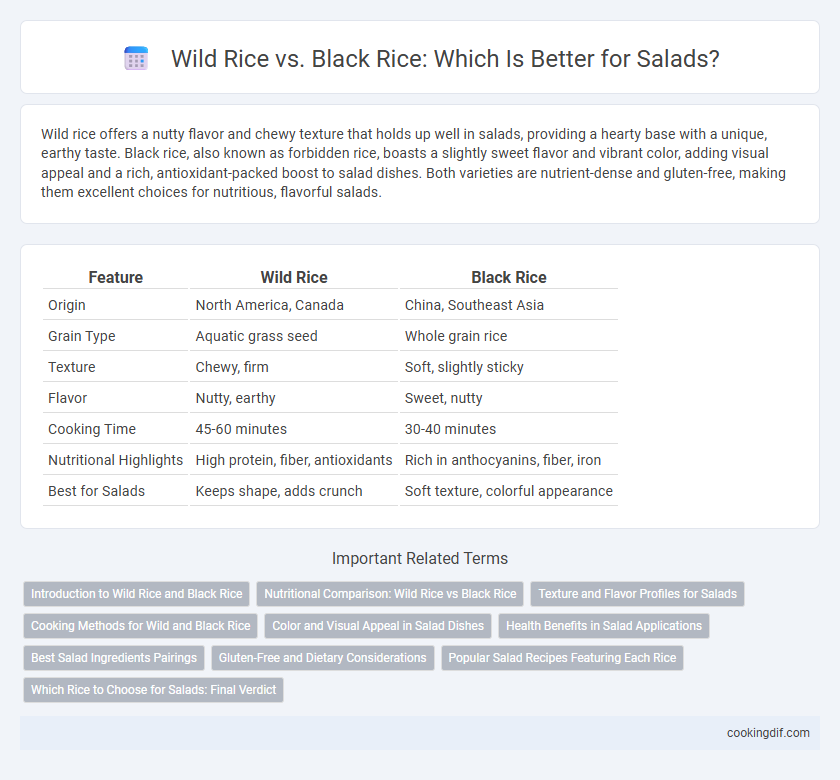Wild rice offers a nutty flavor and chewy texture that holds up well in salads, providing a hearty base with a unique, earthy taste. Black rice, also known as forbidden rice, boasts a slightly sweet flavor and vibrant color, adding visual appeal and a rich, antioxidant-packed boost to salad dishes. Both varieties are nutrient-dense and gluten-free, making them excellent choices for nutritious, flavorful salads.
Table of Comparison
| Feature | Wild Rice | Black Rice |
|---|---|---|
| Origin | North America, Canada | China, Southeast Asia |
| Grain Type | Aquatic grass seed | Whole grain rice |
| Texture | Chewy, firm | Soft, slightly sticky |
| Flavor | Nutty, earthy | Sweet, nutty |
| Cooking Time | 45-60 minutes | 30-40 minutes |
| Nutritional Highlights | High protein, fiber, antioxidants | Rich in anthocyanins, fiber, iron |
| Best for Salads | Keeps shape, adds crunch | Soft texture, colorful appearance |
Introduction to Wild Rice and Black Rice
Wild rice, an aquatic grass seed native to North America, offers a nutty flavor and firm texture ideal for robust salads, while black rice, also known as forbidden rice, is an Asian heirloom variety valued for its deep color, sweet taste, and rich antioxidant content. Both wild and black rice provide high fiber and protein, enhancing the nutritional profile of salads with complex carbohydrates and essential minerals such as iron and magnesium. Choosing between wild and black rice depends on desired flavor intensity and visual appeal, making either an excellent base for nutritious, vibrant salad recipes.
Nutritional Comparison: Wild Rice vs Black Rice
Wild rice offers higher protein content and fiber compared to black rice, making it a nutrient-dense option for salads. Black rice contains more antioxidants, particularly anthocyanins, which contribute to its rich color and offer anti-inflammatory benefits. Both wild rice and black rice provide essential minerals, but black rice is richer in iron and vitamin E, supporting immune and skin health.
Texture and Flavor Profiles for Salads
Wild rice offers a firm, chewy texture with a nutty, earthy flavor that enhances salad complexity and provides a satisfying bite. Black rice features a slightly sticky, tender texture and a mildly sweet, robust taste, adding a rich color contrast and subtle depth to salads. Both varieties contribute distinctive texture and flavor profiles, making them ideal for diverse salad preparations.
Cooking Methods for Wild and Black Rice
Wild rice requires longer cooking times, typically 45-60 minutes, and benefits from soaking beforehand to achieve a tender yet chewy texture ideal for salads. Black rice cooks faster, around 30-35 minutes, and its nutty flavor and slightly sticky texture complement fresh vegetables and dressings well. Both types retain their shape and firmness when cooked properly, making them excellent bases for nutrient-rich, visually appealing salads.
Color and Visual Appeal in Salad Dishes
Wild rice offers a striking contrast with its long, dark grains and earthy tones, enhancing the visual appeal in salad dishes that benefit from rustic, natural colors. Black rice features a deep purple-black hue and glossy texture, adding an elegant, vibrant pop of color that complements bright vegetables and fresh herbs in salads. The choice between wild rice and black rice for salads depends on the desired color palette: wild rice provides a rich, natural aesthetic, while black rice delivers bold, dramatic visual interest.
Health Benefits in Salad Applications
Wild rice contains higher protein and fiber content compared to black rice, enhancing satiety and digestive health in salad applications. Black rice is rich in anthocyanins and antioxidants, promoting anti-inflammatory benefits and cardiovascular health when included in salads. Both varieties offer nutrient-dense options that improve the nutritional profile and visual appeal of healthy salads.
Best Salad Ingredients Pairings
Wild rice's nutty texture pairs exceptionally well with earthy vegetables like mushrooms and roasted root vegetables, while black rice's slightly sweet, chewy grains complement fresh fruits such as mango and pomegranate seeds. Both rices benefit from the addition of vibrant herbs like cilantro or basil and a tangy vinaigrette dressing to enhance their natural flavors. Combining wild rice with toasted nuts and black rice with creamy avocado creates balanced, nutrient-rich salads ideal for gourmet meals.
Gluten-Free and Dietary Considerations
Wild rice and black rice both offer gluten-free options ideal for salads, catering to individuals with gluten sensitivities or celiac disease. Wild rice boasts a nutty flavor and higher protein content, while black rice provides rich antioxidants and a slightly chewy texture. Both varieties support diverse dietary needs by being low in fat and rich in fiber, helping to enhance the nutritional profile of salads.
Popular Salad Recipes Featuring Each Rice
Wild rice is often celebrated in salads such as wild rice and cranberry salad or wild rice vegetable medley, prized for its nutty flavor and chewy texture that complements fresh greens and nuts. Black rice is popular in Asian-inspired salads like black rice mango salad or black rice and edamame salad, valued for its deep color, slightly sweet taste, and high antioxidant content. Both offer unique textures and flavors, making them versatile bases for nutrient-rich, vibrant salads.
Which Rice to Choose for Salads: Final Verdict
Wild rice offers a nutty flavor and chewy texture, making it ideal for hearty, protein-packed salads, while black rice provides a slightly sweet taste and soft texture that complements fresh vegetables and fruity dressings. Nutritionally, wild rice is high in protein and fiber, which supports satiety and digestion, whereas black rice is rich in antioxidants like anthocyanins that promote heart health. For salads, choose wild rice when looking for a robust, earthy grain base, and black rice when aiming for visually striking dishes with a mild, sweet flavor profile.
Wild rice vs black rice for salads Infographic

 cookingdif.com
cookingdif.com